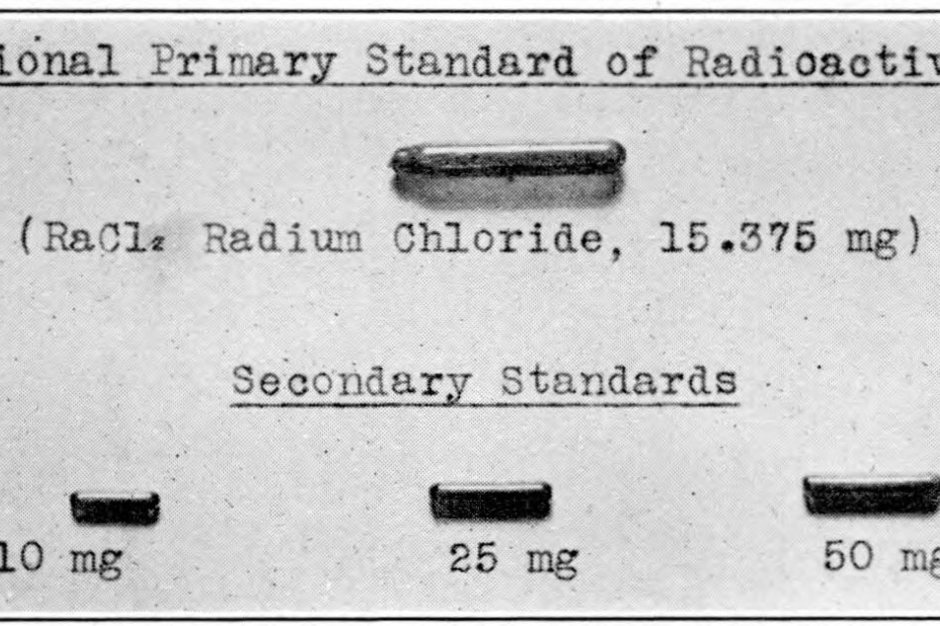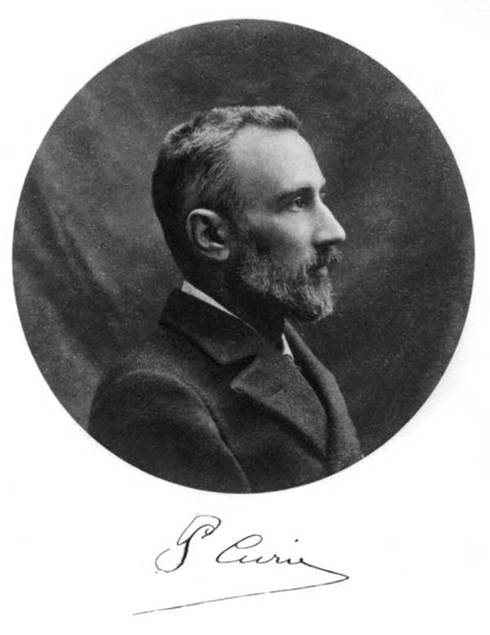The mineralogy of Radium
| About Radium |
|---|
| Radium is a rare radioactive element found as a radioactive decay product in some uranium minerals, in amounts as small as 1/7 gram per ton of uraninite. Although radium does not appear in the formula of any valid mineral species, the unapproved varietal name radiobarite describes a variety of barite with appreciable radium content. Radium is chemically very similar to barium so substitution is quite likely. The substitution of radium for barium is also given as the explanation as to why brazil nuts are 1000 times more radioactive than other similar foods (40-260 Bq/kg) as the extensive root systems of the brazil nut tree help it absorb more barium (and along with it radium) than other similar plants. |
| General Properties | |
|---|---|
| Symbol: | Ra |
| Atomic Number: | 88 |
| Standard atomic weight (Ar): | [226] |
| Electron configuration: | [Rn] 7s2 |
| Photos | ||
|---|---|---|
| < | Radium on copper foil | > |
| Atomic Properties | |
|---|---|
| Electronegativity (Pauling scale): | 0.9 |
| Ionic Radius: | 148 pm (+2) |
| 1st Ionization energy: | 509 kJ/mol |
| Oxidation States: | 2 |
| Physical Properties | |
|---|---|
| Standard State: | solid |
| Bonding Type: | metallic |
| Melting Point: | 973 K |
| Boiling Point: | 2010 K |
| Density: | 5 g/cm3 |
| Metal/Non-Metal: | alkaline earth metal |
| Main isotopes of Radium | ||||
|---|---|---|---|---|
| Isotope | % in Nature | Half Life | Decay type | Decay product |
| 223Ra | trace | 11.43d | α | 219Rn |
| 224Ra | trace | 3.6319d | α | 220Rn |
| 225Ra | trace | 14.9d | β− | 225Ac |
| 226Ra | trace | 1600y | α | 222Rn |
| 228Ra | trace | 5.75y | β− | 228Ac |
| Main ions of Radium | ||||
|---|---|---|---|---|
| Name | Ion | Example minerals | ||
| radium | Ra2+ | |||
| Other Information | |
|---|---|
| Year Discovered: | 1898 |
| Discovered By: | Pierre Curie and Marie Curie |
| Year Isolated: | 1910 |
| Isolated By: | Marie Curie |
| Named For: | Latin: radius -"ray" |
| CPK color coding: | #007D00 |
| External Links: | WikipediaWebElementsLos Alamos National LaboratoryTheodore Gray's PeriodicTable.com |
| Simple Compounds | |||||||||||||||||||||||||||||||||||||||||||||||||||||||||||||||||||||||||||||||||||||||||||||||||||||||||||||||||||||||||||||||||||||||||||||||||||||||
|---|---|---|---|---|---|---|---|---|---|---|---|---|---|---|---|---|---|---|---|---|---|---|---|---|---|---|---|---|---|---|---|---|---|---|---|---|---|---|---|---|---|---|---|---|---|---|---|---|---|---|---|---|---|---|---|---|---|---|---|---|---|---|---|---|---|---|---|---|---|---|---|---|---|---|---|---|---|---|---|---|---|---|---|---|---|---|---|---|---|---|---|---|---|---|---|---|---|---|---|---|---|---|---|---|---|---|---|---|---|---|---|---|---|---|---|---|---|---|---|---|---|---|---|---|---|---|---|---|---|---|---|---|---|---|---|---|---|---|---|---|---|---|---|---|---|---|---|---|---|---|---|
| Oxides | radium oxide | RaO | +2 | ||||||||||||||||||||||||||||||||||||||||||||||||||||||||||||||||||||||||||||||||||||||||||||||||||||||||||||||||||||||||||||||||||||||||||||||||||||
| Geochemistry of Radium | |
|---|---|
| Goldschmidt classification: | Lithophile |
| Elemental Abundance for Radium | ||
|---|---|---|
| Crust (CRC Handbook) | 9 x 10-13 | mass fraction, kg/kg |
| Sea Water (CRC Handbook) | 8.9 x 10-17 | mass per volume fraction, kg/L |
| Periodic Table | |||||||||||||||||||||||||||||||||||||||||||||||||||||||||||||||||||||||||||||||||||||||||||||||||||||||||||||||||||||||||||||||||||||||||||||||||||||||
|---|---|---|---|---|---|---|---|---|---|---|---|---|---|---|---|---|---|---|---|---|---|---|---|---|---|---|---|---|---|---|---|---|---|---|---|---|---|---|---|---|---|---|---|---|---|---|---|---|---|---|---|---|---|---|---|---|---|---|---|---|---|---|---|---|---|---|---|---|---|---|---|---|---|---|---|---|---|---|---|---|---|---|---|---|---|---|---|---|---|---|---|---|---|---|---|---|---|---|---|---|---|---|---|---|---|---|---|---|---|---|---|---|---|---|---|---|---|---|---|---|---|---|---|---|---|---|---|---|---|---|---|---|---|---|---|---|---|---|---|---|---|---|---|---|---|---|---|---|---|---|---|
| |||||||||||||||||||||||||||||||||||||||||||||||||||||||||||||||||||||||||||||||||||||||||||||||||||||||||||||||||||||||||||||||||||||||||||||||||||||||
| Francium << Radium >> Actinium | |||||||||||||||||||||||||||||||||||||||||||||||||||||||||||||||||||||||||||||||||||||||||||||||||||||||||||||||||||||||||||||||||||||||||||||||||||||||
Spotted a mistake/omission? - These pages are a work in progress, so please send all comments/corrections to jolyon@mindat.org. Thank you.
Constants and physical property data from:
David R. Lide (ed.), CRC Handbook of Chemistry and Physics, 85th Edition. CRC Press. Boca Raton, Florida (2005).
Kaye and Laby Tables of Physical & Chemical Constants (2005). Section 3.1.3, Abundances of the elements
A. Earnshaw, N. Greenwood, Chemistry of the Elements, 2nd edition, Butterworth-Heinemann, (1997)
Thomas J. Ahrens (ed.), Global Earth Physics : A Handbook of Physical Constants, American Geophysical Union (1995)
L.B. Railsback, An Earth Scientist's Periodic Table of the Elements and Their Ions : Geology 31:9 p737-740 (2003)
Emsley, J. Nature's Building Blocks: An A-Z Guide to the Elements. New York: Oxford University Press (2001)









